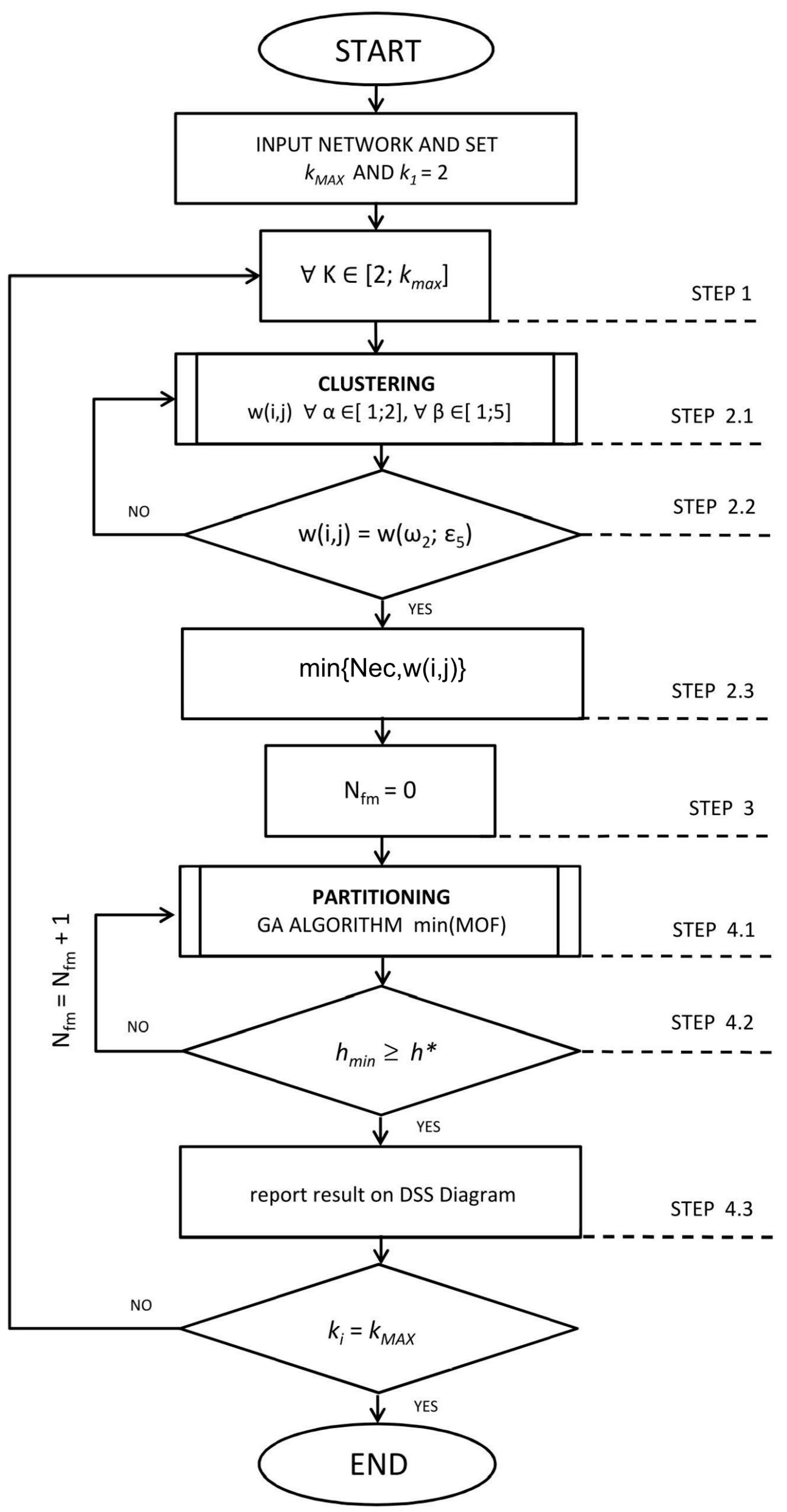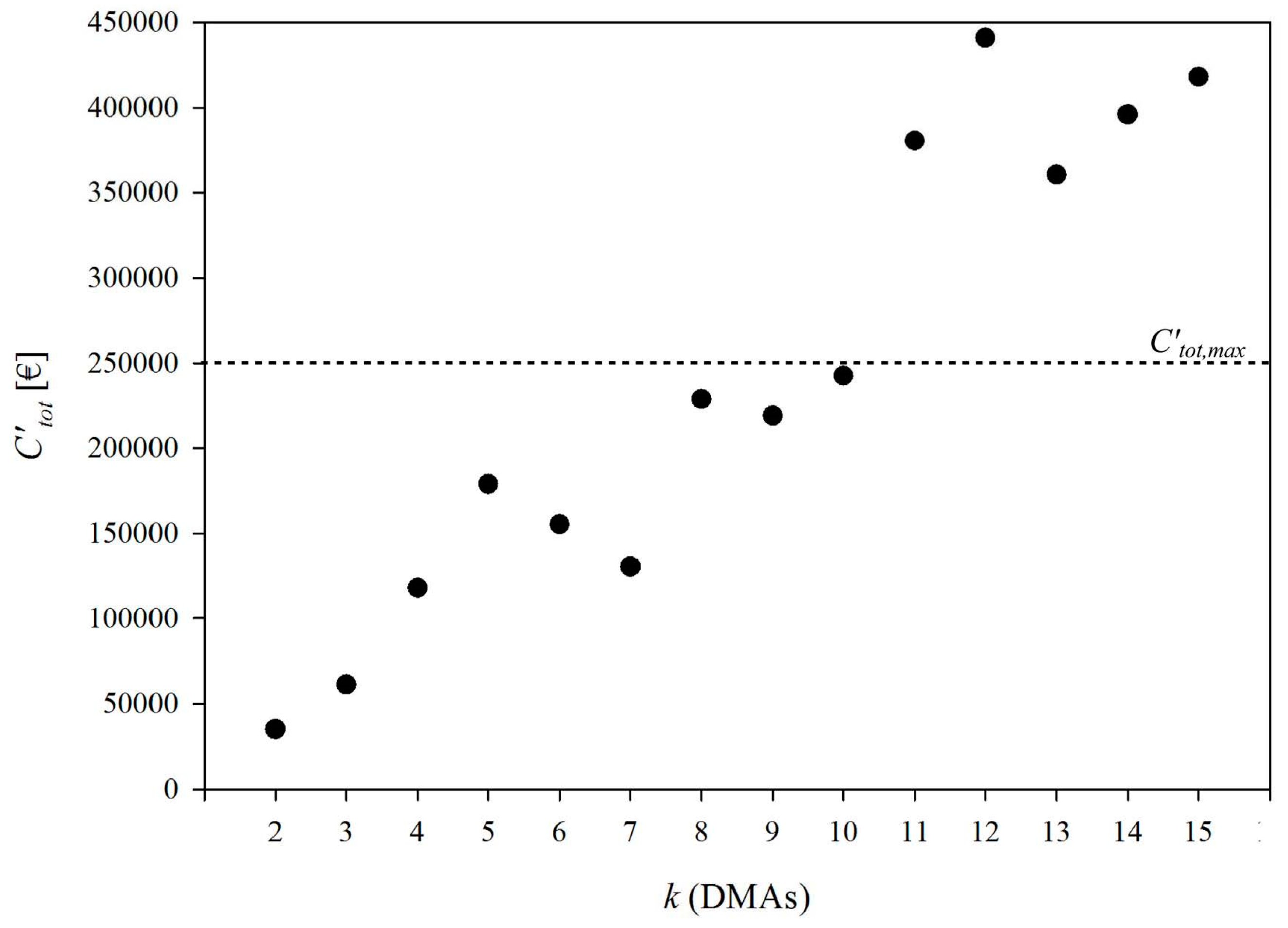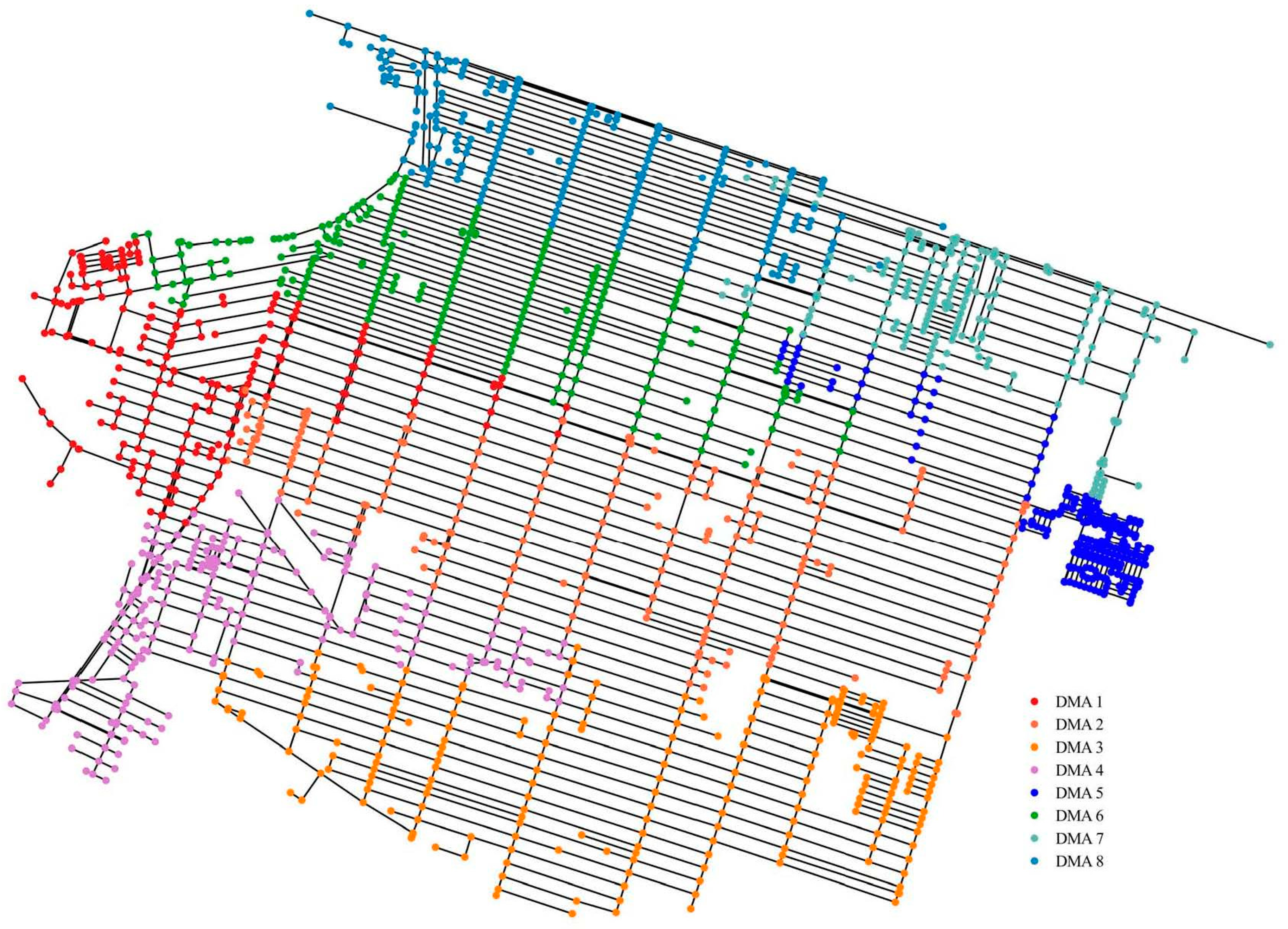Economic and Energy Criteria for District Meter Areas Design of Water Distribution Networks
Abstract
:1. Introduction
2. Decision Support System for Water Network Partitioning
3. Results and Discussion
3.1. Case Study
3.2. Assessment Results of the Multi-Objective Function
3.3. Assessment Results of Hydraulic and Topological Performance Indices
4. Conclusions
Acknowledgments
Author Contributions
Conflicts of Interest
References
- Estrada, E. Network robustness to targeted attacks. The interplay of expansibility and degree distribution. Eur. Phys. J. B 2006, 52, 563–574. [Google Scholar] [CrossRef]
- Morrison, J.; Tooms, S.; Rogers, D. District Metered Areas: Guidance notes. In IWA Water Loss Task Force; IWA Publishing: London, UK, 2007. [Google Scholar]
- Gomes, R.; Marques, A.; Sousa, J. Decision support system to divide a large network into suitable District Metered Areas. Water Sci. Technol. 2012, 65, 1667–1675. [Google Scholar] [CrossRef] [PubMed]
- Alvisi, S.; Franchini, M. A heuristic procedure for the automatic creation of district metered areas in water distribution systems. Urban Water 2014, 11, 137–159. [Google Scholar] [CrossRef]
- Di Nardo, A.; Di Natale, M.; Santonastaso, G.F.; Tzatchkov, V.G.; Alcocer-Yamanaka, V.H. Divide and conquer partitioning techniques for smart water networks. Procedia Eng. 2014, 89, 1176–1183. [Google Scholar] [CrossRef]
- Chambers, K.; Creasey, J.; Forbes, J. Design and operation of distribution networks. In Safe Piped Water: Managing Microbial Water Quality in Piped Distribution Systems; Ainsworth, R., Ed.; IWA Publishing: London, UK, 2004. [Google Scholar]
- Kunkel, G. Committee report: Applying worldwide BMPs in water loss control. J. Am. Water Work. Assoc. 2003, 95, 65–79. [Google Scholar]
- De Paola, F.; Fontana, N.; Galdiero, E.; Giugni, M.; Savic, D.; Sorgenti degli Uberti, G. Automatic multi-objective sectorization of a water distribution network. Procedia Eng. 2014, 89, 1200–1207. [Google Scholar] [CrossRef]
- Galdiero, E.; De Paola, F.; Fontana, N.; Giugni, M.; Savic, D. Decision Support System for the optimal design of District Metered Areas. J. Hydroinform. 2015, 18, 49–61. [Google Scholar] [CrossRef]
- Creaco, E.; Pezzinga, G. Multiobjective Optimization of Pipe Replacements and Control Valve Installations for Leakage Attenuation in Water Distribution Networks. J. Water Resour. Plan. Manag. 2014, 141, 04014059. [Google Scholar] [CrossRef]
- Grayman, W.M.; Murray, R.; Savic, D. Effects of redesign of water systems for security and water quality factors. In Proceedings of the World Environmental and Water Resources Congress, Kansas City, MO, USA, 17–21 May 2009; pp. 1–11. [Google Scholar]
- Di Nardo, A.; Di Natale, M.; Musmarra, D.; Santonastaso, G.F.; Tzatchkov, V.; Alcocer-Yamanaka, V.H. Dual-use value of network partitioning for water system management and protection from malicious contamination. J. Hydroinform. 2015, 17, 361–376. [Google Scholar] [CrossRef]
- Ostfeld, A.; Salomons, E. Optimal early warning monitoring system layout for water networks security: Inclusion of sensors sensitivities and response delays. Civ. Eng. Environ. Syst. 2005, 22, 151–169. [Google Scholar] [CrossRef]
- Pasha, M.F.K.; Lansey, K. Water quality parameter estimation for water distribution systems. Civ. Eng. Environ. Syst. 2009, 26, 231–248. [Google Scholar] [CrossRef]
- Perelman, L.S.; Allen, M.; Preis, A.; Iqbal, M.; Whittle, A.J. Automated sub-zoning of water distribution systems. Environ. Model. Softw. 2015, 65, 1–14. [Google Scholar] [CrossRef]
- Deuerlein, J.W. Decomposition model of a general water supply network graph. J. Hydraul. Eng. 2008, 134, 822–832. [Google Scholar] [CrossRef]
- Perelman, L.; Ostfeld, A. Topological clustering for water distribution systems analysis. Environ. Model. Softw. 2011, 26, 969–972. [Google Scholar] [CrossRef]
- Ferrari, G.; Savic, D.; Becciu, G. Graph-theoretic approach and sound engineering principles for design of district metered areas. J. Water Resour. Plann. Manag. 2014, 140, 04014036. [Google Scholar] [CrossRef]
- Izquierdo, J.; Herrera, M.; Montalvo, I.; Perez-Garcia, R. Division of Water Distribution Systems into District Metered Areas Using a Multi-Agent Based Approach. Commun. Comput. Inf. Sci. 2011, 50, 167–180. [Google Scholar]
- Diao, K.; Zhou, Y.; Rauch, W. Automated creation of district metered area boundaries in water distribution systems. J. Water Resour. Plan. Manag. 2013, 139, 184–190. [Google Scholar] [CrossRef]
- Herrera, M.; Canu, S.; Karatzoglou, A.; Perez-Garcia, R.; Izquierdo, J. An Approach to Water Supply Clusters by Semi-Supervised Learning. In Proceedings of the International Environmental Modelling and Software Society (iEMSs), Ottawa, ON, Canada, 5–8 July 2011; Swayne, D.A., Yang, W., Voinov, A., Rizzoli, A., Filatova, T., Eds.; pp. 1925–1932. [Google Scholar]
- Di Nardo, A.; Di Natale, M.; Giudicianni, C.; Greco, R.; Santonastaso, G.F. Water supply network partitioning based on weighted spectral clustering. In International Workshop on Complex Networks and their Applications; Springer International Publishing: Warsaw, Poland, 2016; Volume 693, pp. 797–807. [Google Scholar]
- Alvisi, S. A New Procedure for Optimal Design of District Metered Areas Based on the Multilevel Balancing and Refinement Algorithm. Water Resour. Manag. 2015, 29, 4397–4409. [Google Scholar] [CrossRef]
- Karypis, G.; Kumar, V. Multilevel k-way partitioning scheme for irregular graphs. J. Parallel Distrib. Comput. 1998, 48, 96–129. [Google Scholar] [CrossRef]
- Di Nardo, A.; Di Natale, M.; Santonastaso, G.F.; Venticinque, S. An automated tool for smart water network partitioning. Water Resour. Manag. 2013, 27, 4493–4508. [Google Scholar] [CrossRef]
- Campbell, E.; Izquierdo, J.; Montalvo, I.; Pérez-García, R. A Novel Water Supply Network Sectorization Methodology Based on a Complete Economic Analysis, Including Uncertainties. Water 2016, 8, 179. [Google Scholar] [CrossRef]
- Watts, D.; Strogatz, S. Collective Dynamics of Small World Networks. Nature 1998, 393, 440–442. [Google Scholar] [CrossRef] [PubMed]
- Barabasi, A.L.; Albert, R. The Emergence of Scaling in Random Networks. Science 1999, 286, 797–817. [Google Scholar]
- Yazdani, A.; Jeffrey, P. Complex network analysis of water distribution systems. Chaos: Interdiscip. J. Nonlinear Sci. 2011, 21, 016111. [Google Scholar] [CrossRef] [PubMed]
- Di Nardo, A.; Di Natale, M.; Giudicianni, C.; Musmarra, D.; Santonastaso, G.F.; Simone, A. Water distribution system clustering and partitioning based on social network algorithms. Procedia Eng. 2015, 119, 196–205. [Google Scholar] [CrossRef]
- Fernández, A.M.H. Improving Water Network Management by Efficient Division into Supply Clusters. Ph.D. Thesis, Universitat Politécnica de Valencia, Valencia, Spain, 2011. [Google Scholar]
- Rossman, L.A. EPANET2 Users Manual; US E.P.A.: Cincinnati, OH, USA, 2000. [Google Scholar]
- Caramia, M.; Dell’Olmo, P. Multi-Objective Management in Freight Logistic; Springer: Berlin, Germany, 2008. [Google Scholar]
- Todini, E. Looped water distribution networks design using a resilience index based heuristic approach. Urban Water 2000, 2, 115–122. [Google Scholar] [CrossRef]
- Boccaletti, S.; Latora, V.; Moreno, Y.; Chavez, M.; Hwanga, D.U. Complex networks: Structure and dynamics. Phys. Rep. 2006, 424, 175–308. [Google Scholar] [CrossRef]
- Tzatchkov, V.G.; Alcocer-Yamanaka, V.H.; Rodriguez-Varela, J.M. Water Distribution Network Sectorization Projects in Mexican Cities along the Border with USA. In Proceedings of the 3rd International Symposium on Transboundary Water Management, Ciudad Real, Spain, 30 May–2 June 2006; pp. 1–13. [Google Scholar]
- Di Nardo, A.; Di Natale, M.; Santonastaso, G.F.; Tzatchkov, V.; Alcocer Yamanaka, V.H. Water Network Sectorization based on a genetic algorithm and minimum dissipated power paths. Water Sci. Technol. Water Supply 2014, 13, 951–957. [Google Scholar] [CrossRef]
- Fiedler, M. Algebraic connectivity of graphs. Czech. Math. J. 1973, 23, 298. [Google Scholar]





| ε1j (No Weight) | ε2j (Flow) | ε3j (Diameter) | ε4j (Length) | ε5j (Dis. Power) | |
|---|---|---|---|---|---|
| ω1j (No weight) | w(1,1) | w(1,2) | w(1,3) | w(1,4) | w(1,5) |
| ω2j (demand) | w(2,1) | w(2,2) | w(2,3) | w(2,4) | w(2,5) |
| Characteristic | Value |
|---|---|
| Number of nodes n | 1890 |
| Number of links m | 2681 |
| Number of wells w | 18 |
| Number of service connections ncTOT | 48,400 |
| Head of well pumps [m] | −2.00; −8.87; −6.45; −2.85; −9.38; −0.75; −4.10; −7.23; 0.05; 0.62; −3.19; −3.80; 3.55; 2.43; −7.32; −3.71; 1.85; 3.73 |
| Total pipe length lTOT [km] | 599.1 |
| Minimum ground elevation zMIN [m] | 0.00 |
| Maximum ground elevation zMAX [m] | 40.10 |
| Pipe materials | PVC and AC |
| Pipe diameters [mm] | 60; 62.5; 75; 100; 150; 200; 250; 300; 350; 400; 450; 500 |
| Average demand. Q [L/s] | 1127.92 |
| Peak demand Q [L/s] | 1735.26 |
| Design pressure h* [m] | 12.00 |
| Unit energy cost c [€/kWh] | 0.09 |
| Pipe Diameter [mm] | Flow Meter Cost [€] | Gate Valve Cost [€] |
|---|---|---|
| 50 | 1974 | 520 |
| 65 | 2073 | 560 |
| 80 | 2073 | 592 |
| 100 | 2187 | 676 |
| 125 | 2325 | 784 |
| 150 | 2586 | 940 |
| 200 | 2970 | 1232 |
| 250 | 3990 | 1792 |
| 300 | 5109 | 2228 |
| 350 | 5652 | 3242 |
| 400 | 6282 | 4412 |
| 450 | 6726 | 5964 |
| 500 | 7125 | 9122 |
| 600 | 8265 | 11,406 |
| 700 | 10,599 | 15,578 |
| 800 | 12,909 | 21,177 |
| 900 | 16,011 | 27,198 |
| 1000 | 19,353 | 33,989 |
| k [-] | Nck [-] | Nec [-] | Nfm [-] | Nbv [-] | PN [W] | MOF [-] | Cfm+gv [€] | CΔE [€/Year] | C’tot [€] |
|---|---|---|---|---|---|---|---|---|---|
| 1 | - | - | - | - | 104,936.44 | - | - | - | - |
| 2 | 1 | 16 | 0 | 16 | 101,962.58 | 2.01 | 25,726.13 | −281.08 | 35,111.68 |
| 3 | 1 | 26 | 0 | 26 | 101,365.40 | 2.02 | 36,733.56 | −120.03 | 61,103.94 |
| 4 | 1,533,939 | 47 | 5 | 42 | 102,831.98 | 2.01 | 69,377.52 | −156.16 | 118155.32 |
| 5 | 61,474,519 | 62 | 9 | 53 | 102,863.55 | 2.02 | 103,115.38 | −147.33 | 178,919.18 |
| 6 | 6.52 × 1013 | 67 | 8 | 59 | 100,619.71 | 2.03 | 97,803.87 | −505.03 | 155,459.53 |
| 7 | 1.47 × 1013 | 72 | 7 | 65 | 102,156.07 | 2.01 | 102,763.27 | −1373.63 | 130,471.94 |
| 8 | 1.80 × 1020 | 85 | 17 | 68 | 104,206.23 | 1.99 | 126,708.65 | 44.73 | 228,660.08 |
| 9 | 3.53 × 1019 | 77 | 15 | 62 | 104,767.04 | 1.01 | 123,656.96 | −65.85 | 218,883.30 |
| 10 | 3.15 × 1021 | 92 | 16 | 76 | 104,560.70 | 2.01 | 146,992.26 | −530.07 | 242,571.74 |
| 11 | 2.16 × 1028 | 108 | 26 | 82 | 104,216.64 | 1.01 | 181,208.25 | 1435.99 | 380,509.48 |
| 12 | 2.98 × 1031 | 122 | 28 | 94 | 102,889.14 | 1.03 | 208,214.42 | 1744.91 | 440,918.92 |
| 13 | 4.75 × 1031 | 129 | 29 | 100 | 103,304.48 | 2.01 | 203,090.31 | −86.48 | 360,331.58 |
| 14 | 7.19 × 1032 | 135 | 30 | 105 | 101,905.98 | 1.04 | 220,366.52 | 36.12 | 396,051.14 |
| 15 | 5.42 × 1033 | 138 | 31 | 107 | 102,555.23 | 2.03 | 222,936.65 | 486.62 | 418,220.20 |
| k [-] | hmean [m] | hmin [m] | Ir [-] | Ird [%] | Ef [W] | λ2 [-] | mα [-] | SDnc [-] | SDl [-] |
|---|---|---|---|---|---|---|---|---|---|
| 1 | 26.63 | 16.31 | 0.803 | 0.00 | 0.0520 | 0.0009 | 1 | - | - |
| 2 | 26.63 | 13.42 | 0.710 | 11.58 | 0.0366 | 0.0000 | 2 | 1.43 | 0.16 |
| 3 | 25.58 | 13.92 | 0.722 | 10.09 | 0.0343 | 0.0000 | 3 | 0.72 | 2.11 |
| 4 | 25.93 | 15.26 | 0.750 | 6.60 | 0.0458 | 0.0004 | 1 | 6.31 | 6.25 |
| 5 | 26.10 | 15.15 | 0.763 | 4.98 | 0.0464 | 0.0003 | 1 | 0.45 | 1.15 |
| 6 | 25.69 | 12.96 | 0.690 | 14.07 | 0.0330 | 0.0000 | 2 | 6.75 | 5.93 |
| 7 | 26.07 | 14.93 | 0.759 | 5.48 | 0.0383 | 0.0000 | 2 | 5.51 | 5.52 |
| 8 | 27.00 | 14.75 | 0.764 | 4.86 | 0.0457 | 0.0005 | 1 | 5.15 | 4.77 |
| 9 | 27.91 | 12.56 | 0.761 | 5.23 | 0.0384 | 0.0000 | 2 | 4.32 | 4.64 |
| 10 | 27.42 | 12.12 | 0.765 | 4.73 | 0.0348 | 0.0000 | 2 | 4.68 | 4.39 |
| 11 | 26.99 | 12.60 | 0.736 | 8.34 | 0.0440 | 0.0003 | 1 | 3.69 | 3.51 |
| 12 | 26.38 | 12.01 | 0.701 | 12.70 | 0.0425 | 0.0003 | 1 | 3.79 | 3.56 |
| 13 | 26.75 | 15.37 | 0.734 | 8.59 | 0.0443 | 0.0005 | 1 | 3.31 | 3.09 |
| 14 | 26.49 | 13.02 | 0.667 | 16.94 | 0.0444 | 0.0004 | 1 | 0.11 | 0.13 |
| 15 | 26.85 | 15.01 | 0.698 | 13.08 | 0.0431 | 0.0005 | 1 | 0.13 | 1.07 |
© 2017 by the authors. Licensee MDPI, Basel, Switzerland. This article is an open access article distributed under the terms and conditions of the Creative Commons Attribution (CC BY) license (http://creativecommons.org/licenses/by/4.0/).
Share and Cite
Di Nardo, A.; Di Natale, M.; Giudicianni, C.; Santonastaso, G.F.; Tzatchkov, V.; Varela, J.M.R. Economic and Energy Criteria for District Meter Areas Design of Water Distribution Networks. Water 2017, 9, 463. https://doi.org/10.3390/w9070463
Di Nardo A, Di Natale M, Giudicianni C, Santonastaso GF, Tzatchkov V, Varela JMR. Economic and Energy Criteria for District Meter Areas Design of Water Distribution Networks. Water. 2017; 9(7):463. https://doi.org/10.3390/w9070463
Chicago/Turabian StyleDi Nardo, Armando, Michele Di Natale, Carlo Giudicianni, Giovanni Francesco Santonastaso, Velitchko Tzatchkov, and José Manuel Rodriguez Varela. 2017. "Economic and Energy Criteria for District Meter Areas Design of Water Distribution Networks" Water 9, no. 7: 463. https://doi.org/10.3390/w9070463




